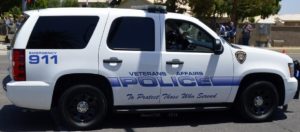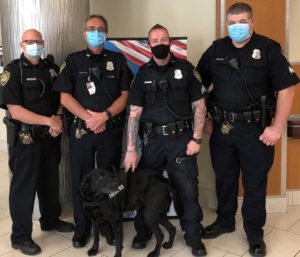
At the Carl T. Hayden VAMC in Phoenix, where this photo was taken, 98% of the officers are military veterans. Congress is seeking to overall the VA police. Photo from Phoenix VA Healthcare System website
WASHINGTON — VA’s police force will likely soon be equipped with body-worn cameras, either through the department’s own initiative or by legislative fiat.
Officials advised that the cameras will provide invaluable data about police interaction with veterans, visitors and staff. The cameras will not fix what legislators and VA watchdogs describe as the overly complicated bureaucracy in charge of VA police, however.
The VA Police Force Improvement and Accountability Act (H.R. 2429), which passed the House in June, would require not only body-worn cameras for its 4,000-person police force but also that VA would make it easier for members of the public to obtain information about specific force-related incidents. It would require VA police to promptly report all uses of force to agency leadership, who must then review and investigate each incident.
According to VA officials, there were 5,002 violent incidents on VA campuses in 2020 which required police intervention.
VA officials have gone on record in the past as being in favor of the implementation of body-worn cameras. Still, department leaders recently balked at the cost, process and timeline for implementation that the legislation would require.
At a House VA Subcommittee on Oversight and Investigations hearing last month, VA officials said that body-worn cameras will be implemented and that the department is investigating the best way to do so.
“We have a draft policy for body-worn cameras, and we’re working with VHA to conduct multiple pilots to investigate the feasibility and requirements of implementing body-worn cameras across our campuses,” explained Lewis Ratchford, VA’s chief security officer. “We believe body-worn cameras are something that’s necessary for accountability for VA police. Once that [draft] policy is complete, it will be shared with the entire department and any entity that wants to see that policy.”
More Transparency
According to Troy Brown, VHA’s senior security officer, the pilot programs showed that body-worn cameras do create more transparency and allow officials to better understand incidents after the fact. They also can provide live coverage so that VA can manage serious incidents as they occur.
Government Accountability Office (GAO) investigations of incidents involving VA police have found that a lack of data makes it difficult to determine whether force-related incidents were handled properly.
“We found three data issues, which collectively limited oversight,” explained Leigh Searight, GAO’s deputy assistant inspector general for audits and evaluations. “[Those include] incomplete characterizing of the type of force used, inaccurate data on the highest force used and potential for duplicate data entries.”
Database for Incidents
While body-worn cameras should help fill in that data gap, VA also is working on creating a new central database to store information on force-related incidents.
Subcommittee members impressed on VA officials that a well-funded, properly-staffed and closely overseen police force is essential to veterans’ safety and health. Investigations into attempted and completed suicides at VA facilities have found that VA police can play a key role in determining the outcome of those incidents.
“For veterans in crisis coming to a VA facility, VA police officers may be the first people they encounter and the first to have the opportunity to offer help,” declared Subcommittee Chair Rep. Chris Pappas (D-NH ).
Legislators’ skepticism about VA’s ability to implement substantial reforms in a timely manner stems from the bifurcated administrative structure of VA’s police force. While policy and oversight is handled by Human Resources Administration/Operations, Security, and Preparedness (HRA/OSP), the day-to-day operations of the force is run through VHA.
GAO, along with VA’s Office of the Inspector General (OIG), has flagged this structure as contributing to poor management and slow reforms in the past. In 2019, an OIG investigation found that VA did not have adequate or coordinated governance over its police force, placing much of the blame at the feet of this split administrative structure.
VA has said it believes it has addressed at least one of the OIG’s concerns—inadequate staffing models at its facilities. The department has created a decision-making tool that will help individual facility directors determine what they need in terms of security. An annual review will determine whether that model has been implemented.
“The model in theory is a good solution,” declared Searight. “[But] one of the challenges is the funding at each facility and how that facility director chooses to apply that funding to their workforce.”


